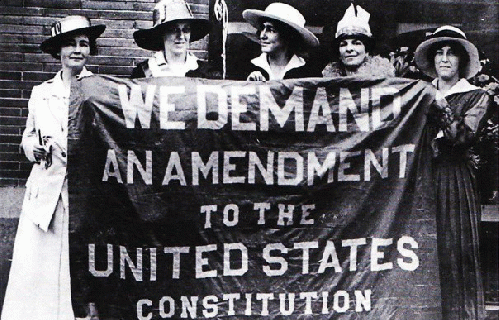By Renee Babcock
>Part I: Universal Suffrage, Allies, and Difficult DecisionsWith the release of the film Suffragette (2015), based on events from the British Women's Suffrage Movement, we take time to celebrate and look back on our own Women's Suffrage Movement in America. The 19th Amendment, which gave women the right to vote, took 80 years to accomplish. It took a movement of millions demanding change, beginning with a few outraged women meeting in their homes to forming minority political groups, and growing into national organizations committing dramatic acts of civil disobedience. Throughout, they maintained a fierce determination to never surrender. Now, as we engage in the long and messy process of movement building to Move to Amend our constitution a 28th time, it is important to learn from the experiences our brave historical sisters.
The women's suffrage movement in the United States began in 1840 when U.S. women delegates were barred from participating in the World Anti-Slavery Convention in London. Elizabeth Cady Stanton and Susan B. Anthony, two of the first leaders of the woman's rights movement, saw the fight for woman's rights as intrinsically tied to the liberation of slaves and freed black men. From this, a strong alliance was formed with the American abolitionist movement in 1850, including Frederick Douglass. At a time when only white property-owning men had full rights, the abolitionist and woman's rights movements struggled over whom they would champion. The American Equal Rights Association (AERA) was formed, dedicated to obtaining the right to vote for all, regardless of gender or race. These aspirations were soon put to the test in the post-Civil War era.
In 1867 the Kansas legislature put two popular referenda on the ballot, one for black suffrage, the other for woman's suffrage. AERA saw this as their opportunity to show that woman's and black suffrage could be united successfully and prove to the dominant Republican Party that there was popular support for woman's suffrage. This was quickly met with a hostile anti-feminist campaign by the Kansas Republicans; justified by saying that woman's suffrage would only hurt black suffrage. Women had to make a tough decision: abandon woman's suffrage for the time to retain the good graces of the powerful political party or remain firm on woman's suffrage now and lose the party support.
While Stanton and Anthony remained unyielding in their call for women's full political equality, other suffragists, like Lucy Stone, one of the first women to receive an academic degree, were willing to step aside; arguing that retaining support of the Republicans and abolitionists would benefit woman's rights once black suffrage had been achieved. Thus began a rift, which would unravel the woman's suffrage movement for the next several decades.
As Stanton and Anthony continued their Kansas campaign, their motivations changed. In anger, desperation, and resentment, they partnered with racist men who supported woman's suffrage and by the end were themselves preaching black inferiority. With such a divisive campaign, neither referendum passed. Reflecting back, Stanton remarked, "I believe both propositions would have carried but with a narrow policy of playing one against the other, both were defeated."
This divide intensified in the debate over the 15th Constitutional Amendment, which enfranchised black men. But this time, with a federal amendment on the line, the stakes were higher, and the already struggling AERA was again wracked with disagreements over whether to support the proposed amendment.
Stanton tried to appeal to potential supporters of white middle-class women by insinuating that they were more worthy of the vote than uneducated, poor black and immigrant men. This rhetoric alienated many pro-black activists. The divided movement put the heaviest burden on black women forced to choose between their race and their sex; dividing their support between Stanton and Anthony's coalition and the abolitionists. In the end, the 15th Amendment passed, but the women's movement was in tatters. The AERA was unable to reunite. Douglass and others could not forgive Stanton and Anthony's racist campaigns.
With the women's leadership so heavily divided, Anthony and Stanton started their own organization, which sought universal suffrage by a constitutional amendment. While Stone's coalition created a separate organization focused on state-by-state campaigns. With two competing organizations and strategies, neither was able to gain any real power or momentum.
(Note: You can view every article as one long page if you sign up as an Advocate Member, or higher).





